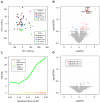Allergen-induced activation of natural killer cells represents an early-life immune response in the development of allergic asthma
- PMID: 29518416
- PMCID: PMC6123299
- DOI: 10.1016/j.jaci.2018.02.019
Allergen-induced activation of natural killer cells represents an early-life immune response in the development of allergic asthma
Abstract
Background: Childhood asthma in inner-city populations is a major public health burden, and understanding early-life immune mechanisms that promote asthma onset is key to disease prevention. Children with asthma demonstrate a high prevalence of aeroallergen sensitization and TH2-type inflammation; however, the early-life immune events that lead to TH2 skewing and disease development are unknown.
Objective: We sought to use RNA sequencing of PBMCs collected at age 2 years to determine networks of immune responses that occur in children with allergy and asthma.
Methods: In an inner-city birth cohort with high asthma risk, we compared gene expression using RNA sequencing in PBMCs collected at age 2 years between children with 2 or more aeroallergen sensitizations, including dust mite, cockroach, or both, by age 3 years and asthma by age 7 years (cases) and matched control subjects who did not have any aeroallergen sensitization or asthma by age 7 years.
Results: PBMCs from the cases showed higher levels of expression of natural killer (NK) cell-related genes. After cockroach or dust mite allergen but not tetanus antigen stimulation, PBMCs from the cases compared with the control subjects showed differential expression of 244 genes. This gene set included upregulation of a densely interconnected NK cell-like gene network reflecting a pattern of cell activation and induction of inflammatory signaling molecules, including the key TH2-type cytokines IL9, IL13, and CCL17, as well as a dendritic cell-like gene network, including upregulation of CD1 lipid antigen presentation molecules. The NK cell-like response was reproducible in an independent group of children with later-onset allergic sensitization and asthma and was found to be specific to only those children with both aeroallergen sensitization and asthma.
Conclusion: These findings provide important mechanistic insight into an early-life immune pathway involved in TH2 polarization, leading to the development of allergic asthma.
Keywords: Asthma; allergens; dendritic cells; natural killer cells; transcriptomics.
Copyright © 2018 American Academy of Allergy, Asthma & Immunology. Published by Elsevier Inc. All rights reserved.
Conflict of interest statement
Figures




Comment in
-
Can natural killer cells represent an early life immune response in development of allergic asthma? More precise data analysis should be considered.J Allergy Clin Immunol. 2018 Aug;142(2):712-713. doi: 10.1016/j.jaci.2018.04.036. Epub 2018 Jun 23. J Allergy Clin Immunol. 2018. PMID: 29945813 No abstract available.
-
Reply.J Allergy Clin Immunol. 2018 Aug;142(2):713. doi: 10.1016/j.jaci.2018.04.035. Epub 2018 Jun 23. J Allergy Clin Immunol. 2018. PMID: 29945814 No abstract available.
-
Sample procedure in peripheral blood mononuclear cells RNA sequencing.J Allergy Clin Immunol. 2019 Jun;143(6):2334. doi: 10.1016/j.jaci.2019.03.007. Epub 2019 Apr 9. J Allergy Clin Immunol. 2019. PMID: 30979656 No abstract available.
-
Reply.J Allergy Clin Immunol. 2019 Jun;143(6):2334-2335. doi: 10.1016/j.jaci.2019.03.006. Epub 2019 Apr 9. J Allergy Clin Immunol. 2019. PMID: 30979657 No abstract available.
References
-
- Barnett SBL, Nurmagambetov TA. Costs of asthma in the United States: 2002–2007. Journal of Allergy and Clinical Immunology. 2011;127(1):145–52. - PubMed
-
- Weiss KB, Gergen PJ, Crain EF. Inner-city asthma. The epidemiology of an emerging US public health concern. Chest. 1992;101(6):362S–7. - PubMed
-
- Crain EF, Weiss KB, Bijur PE, Hersh M, Westbrook L, Stein RE. An estimate of the prevalence of asthma and wheezing among inner-city children. Pediatrics. 1994;94(3):356–62. - PubMed
-
- Macaubas C, de Klerk NH, Holt BJ, Wee C, Kendall G, Firth M, et al. Association between antenatal cytokine production and the development of atopy and asthma at age 6 years. The Lancet. 2003;362(9391):1192–7. - PubMed
-
- Stern DA, Guerra S, Halonen M, Wright AL, Martinez FD. Low IFN-γ production in the first year of life as a predictor of wheeze during childhood. Journal of Allergy and Clinical Immunology. 2007;120(4):835–41. - PubMed
Publication types
MeSH terms
Substances
Grants and funding
- N01 AI025496/AI/NIAID NIH HHS/United States
- UL1 TR001079/TR/NCATS NIH HHS/United States
- UL1 RR024992/RR/NCRR NIH HHS/United States
- M01 RR000071/RR/NCRR NIH HHS/United States
- UM1 AI114271/AI/NIAID NIH HHS/United States
- M01 RR000052/RR/NCRR NIH HHS/United States
- UL1 TR002345/TR/NCATS NIH HHS/United States
- N01 AI025482/AI/NIAID NIH HHS/United States
- M01 RR000533/RR/NCRR NIH HHS/United States
- UL1 RR024156/RR/NCRR NIH HHS/United States
- UM2 AI117870/AI/NIAID NIH HHS/United States
- UL1 RR025771/RR/NCRR NIH HHS/United States
LinkOut - more resources
Full Text Sources
Other Literature Sources
Medical
Molecular Biology Databases

